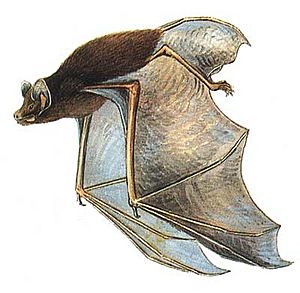Chocolate wattled bat facts for kids
Quick facts for kids Chocolate wattled bat |
|
|---|---|
 |
|
| Conservation status | |
| Scientific classification | |
| Genus: |
Chalinolobus
|
| Species: |
morio
|
| Synonyms | |
|
C. australis (Gray, 1841) |
|
The chocolate wattled bat, known scientifically as Chalinolobus morio, is a small bat found only in Australia. It belongs to a bat family called Vespertilionidae. These bats live across southern Australia, including the island of Tasmania. You can find them from sea level up to high mountains.
Contents
Discovering the Chocolate Wattled Bat
A scientist named John Edward Gray first described this bat in 1841. He gave it the name Chalinolobus morio.
The name Chalinolobus comes from ancient Greek words. Chalinos means 'bridle', and lobos means 'lobe'. The word morio comes from the Greek name Moros, who was known as the "son of night."
The word 'wattled' in the bat's name refers to a special skin flap. This flap is found near the head of some bats in this group.
What Does the Chocolate Wattled Bat Look Like?
This bat has a rich, almost even brown color. It looks a lot like milk chocolate, which is how it got its name! Sometimes, bats in western and central Australia have a lighter color on their front.
These bats are quite small. They usually weigh between 8 and 11 grams. Their forearm, which is part of their wing, measures about 35 to 42 millimeters.
Like other Chalinolobus bats, they have a 'wattle'. This is a small flap of skin that goes from the bottom of their ear to their mouth. The chocolate wattled bat's wattle is smaller than those of its relatives. Its ears are also smaller and more rounded.
These bats are very fast and can move quickly in the air. They are great at twisting and turning while they chase small moths and other insects. Scientists have found that this bat is one of the most agile Australian bats. It can fly with amazing skill.
Where Do Chocolate Wattled Bats Live?
Chocolate wattled bats live in many different places. You can find them in rainforests, open plains, and many other environments. They often rest, or 'roost', in tree hollows, caves, and even buildings.
Their groups, called colonies, can be small or very large. Some colonies have only ten bats, while others have more than a thousand! Female bats usually give birth to one baby bat at a time.
These bats eat only insects. They catch their prey while flying, usually under the tree canopy. Their diet is mostly made up of moths.
You can find these bats in southern Australia. There are also two smaller groups in central Australia and in the Pilbara region. Some groups of bats prefer to roost in trees, while others like caves.
For example, many chocolate wattled bats live in the huge caves of the Nullarbor Plain. In other areas, they prefer to live in hollows inside trees.
These bats are often seen in cities in southern Australia. They are common in Canberra, the capital city. Here, they enjoy a seasonal feast of bogong moths. These moths are often attracted to the parliament building.
C. morio also lives in Tasmania and its capital, Hobart. It is one of the few bat species found there. In Tasmania, they roost in hollows of large eucalypt trees. Caves are often too cold for bats in Tasmania. It is also thought they use old buildings for roosting. These bats are usually the first to wake up after hibernation. This means they can find food without other bats competing for it for several weeks.
In Adelaide, South Australia, there are many parklands. This bat, along with about a dozen other species, uses these areas for finding food and roosting. You can often see them hunting near street lights with other bats.
In Perth, Western Australia, you can find these bats near the city center in Kings Park. They also live in the cave systems to the south, in the Leeuwin-Naturaliste National Park. While they can live in caves and buildings, they most often live in tree hollows. Sadly, the old forests that provide good hollows are much smaller now in the southwest region.
In the Pilbara region, the chocolate wattled bat is one of three bat groups that are separated from others. The other two are the orange leaf-nosed bat and the ghost bat. In this region, the chocolate wattled bat finds its food near rivers and streams.
Interestingly, Chalinolobus morio sometimes uses the nests of fairy martins. These birds build spout-shaped nests from mud. They often build them in quiet spots under concrete bridges. When the birds leave after their breeding season, the bats move in! These bats also sometimes live in roof spaces of buildings.
How Are Chocolate Wattled Bats Protected?
The chocolate wattled bat is listed as Least Concern on the IUCN Red List. This means they are not currently in danger of disappearing. There are no major threats to them right now. They also live in many protected areas.
However, these bats can be affected by changes in how land is used. Losing their habitat due to logging, farming, or building new cities can harm them. In Queensland and the Northern Territory, they are considered 'not threatened'.
See also
 In Spanish: Chalinolobus morio para niños
In Spanish: Chalinolobus morio para niños



